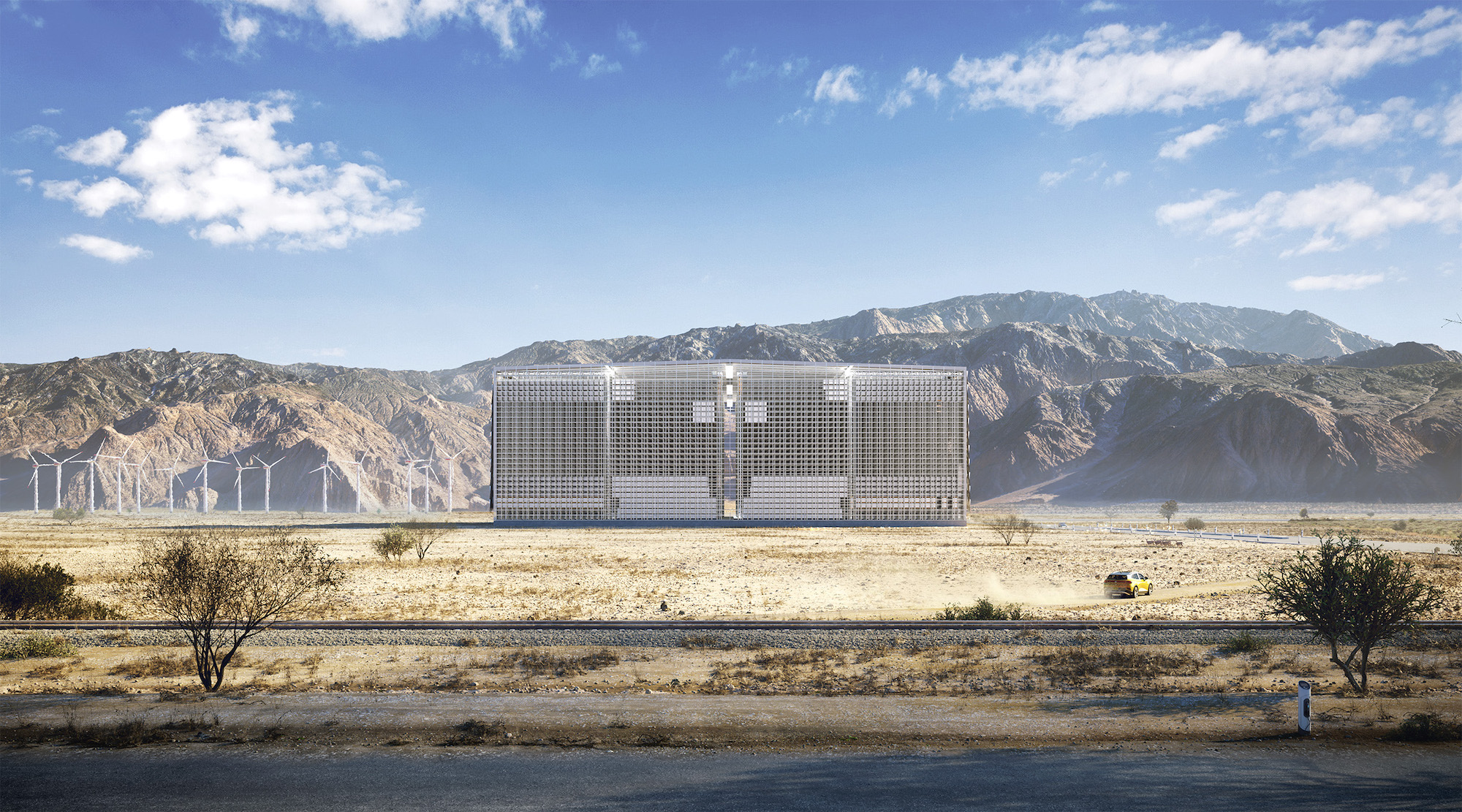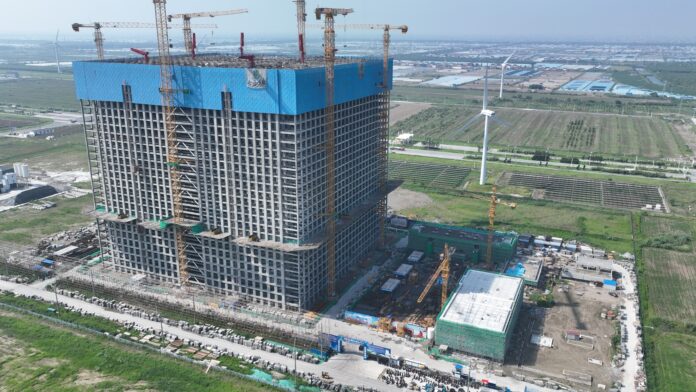Energy Vault Holdings Inc. is close to deploying one of the world’s first gravity-based energy storage systems that functions without the use of water.
The company, which has dual headquarters in Westlake Village and Lugano, Switzerland, expects to complete next quarter a plant near Shanghai, China, that will store and then release energy through the movement of 25-ton composite blocks. The plant, which is about the height of a 20-story building, will be able to store and then deliver up to 25 megawatts of power to China’s electric grid for four hours.
According to the company, this is apparently the first-ever real-world application of gravity-storage technology that does not use water. And it will supplement Energy Vault’s other methods of storing energy, including conventional lithium-ion batteries and using hydrogen produced from renewable sources.
“Our vision is to develop the most sustainable and economic energy storage capacity, using whatever means available,” said Robert Piconi, Energy Vault’s chief executive.
To meet the urgent need for more energy to be available on call, companies have rushed into energy storage. Most companies are deploying lithium-ion batteries for energy storage – including Austin, Texas-based Tesla Inc. and Sawtelle-based B2U Storage Solutions Inc., which assembles used electric vehicle lithium ion batteries.
Several companies have also recently ventured into the storage of hydrogen produced through renewable sources.
Gravity storage
The oldest form of gravity-based energy storage, pumped water, has been around for more than a century. It involves a system with an upper and lower reservoir: energy is used to pump water up to the higher-elevation reservoir and then energy is released when that water is drained into the lower-elevation reservoir, powering turbines as the water drops.
But pumped water-storage projects have their issues. The main difficulty is the huge footprint required: enough land for two sizeable reservoirs and enough vertical topography to make for a significant elevation change between the two reservoirs.
And then there are environmental concerns, as one local company, Eagle Crest Energy of Santa Monica, has discovered. Eagle Crest has a planned 1,300 megawatt pumped water-storage project slated for an abandoned iron mine pit near Joshua Tree National Park. To maintain the overall amount of water in the system, some has to be drawn from local supplies. That has generated opposition from the National Park Service and environmental groups concerned that tapping the local aquifer would harm wildlife habitats.
Eagle Crest’s project received initial approval from federal energy regulators in 2014 but has yet to see any earth turned over.
Piconi and his team at Energy Vault sought to develop a gravity-based system without all the drawbacks of huge volumes of water. They turned to a very old concept: raising and lowering massive blocks of material to release large amounts of stored energy on call.
But while the concept is old, producing enough stored energy to make a difference was for many decades viewed as impractical. That’s because to produce just 40 megawatts of electricity nearly 2,000 blocks weighing 25 tons each ust be moved in unison. Only recently has the automation and computer technology advanced far enough to make this feasible at scale, Piconi said. He likened it to a choreography of movement among the blocks.
Also, building so many of these huge blocks out of concrete is prohibitively expensive, so Energy Vault worked with Monterrey, Mexico-based cement maker Cemex to develop blocks made of less-expensive aggregate materials, primarily dirt from nearby locations and, in some cases, with concrete debris and potash mixed in.
“This is a very unique, novel way to store energy,” Piconi said. “It mirrors what pumped hydro dams do, but it’s much more efficient and without the environmental damage that pumped hydro can cause.”
Another factor behind this push to develop gravity-based storage systems is the burgeoning overall demand for energy storage. As energy grids – especially in places like California – rely more on intermittent wind and solar generation – there’s increasing need to store the energy as it’s generated for use later when these wind and solar plants are offline.
“Up until the last five years or so, there simply hasn’t been enough demand to warrant development of this technology,” said Christopher Ellinghaus, senior utility/alternative energy equity analyst with New York-based Siebert Williams Shank & Co.
Ellinghaus called Energy Vault’s focus on gravity-based energy storage “thinking outside the box” at a time when most attention is on lithium-ion battery technology.
China project

Energy Vault tested the concept with a demonstration project that began in the summer of 2021 in Switzerland using about 100 movable blocks capable of storing 5 megawatts. The project ran for two years.
Now, the company is almost ready for its first-real world test with the plant in Rudong, China, which is located just outside Shanghai. The plant itself is being built by Shanghai-based environmental services and power generation company China Tianying Group; Energy Vault’s technology is being deployed inside the 20-story-tall plant. China Tianyang and another Chinese entity orginally paid Energy Vault a $50 million fee to license the technology.
When fully operational later this year, the plant will be able to store up to 25 megawatts of power generated at an adjacent wind farm by using that power to raise hundreds of composite blocks. Then, through the lowering of the blocks, the power can be released and sent onto China’s national energy grid for a period of up to four hours. The aim is to provide critical storage capacity for intermittently generated renewable energy.
Piconi said the system can technically store power for days at a time, but that there’s little market demand for power to be stored for that long.
He added that Energy Vault is currently siting another similar-sized gravity storage plant in Snyder, a city in the north-central region of Texas. That plant, being developed in partnership with Enel Green Power, a unit of Rome-based Enel Group, could come on line by the end of 2024, he said. If it does, it would be the first gravity-based energy storage plant in the United States.
Other methods
Energy Vault is also pushing ahead on other types of energy storage, including the more conventional lithium-ion battery technology.
For example, Energy Vault has partnered with Sacramento-based Wellhead Energy to install a 69-megawatt battery-storage system at a natural gas-fired peaker plant in Stanton in northern Orange County. A peaker plant is designed to operate on an intermittent basis, bringing on additional power when the demand exceeds the supply from full-time generation facilities, such as during extensive heat waves. Under Wellhead’s contract with Southern California Edison, the electric utility subsidiary of Rosemead-based Edison International, the plant is being upgraded with the battery-storage system to increase its efficiency and minimize the time that the turbines must work. SCE has set a deadline of August 1 to ensure the upgraded plant is ready for service in time for peak summer demand.
Hal Dittmer, Wellhead’s chief executive, said tying the battery storage facility to the operation of a peaker plant allows the power generated by that plant to be stretched out for a longer period of time, thereby reducing the overall amount of time that the natural gas turbines at the plant are in operation.
Dittmer said Wellhead learned about Energy Vault through a series of industry networking relationships. And, he said, as the battery-storage project was put out to bid, Energy Vault was the only company that could promise to deliver the 15,000-plus lithium-ion batteries needed on time.
“There were supply chain issues across the board, but Energy Vault nonetheless was able to promise – and then deliver – the batteries needed for the project,” Dittmer said.
He added that Energy Vault’s technology platform, which integrates parts from different suppliers, including inverters and transformers, has been a key ingredient in the project moving forward.
Energy Vault is also working on a hydrogen-storage facility in the northern California city of Calistoga for Pacific Gas & Electric, the utility subsidiary of San Francisco-based PG&E Corp.
Under this contract, Energy Vault is supplying the fuel cell battery technology to store hydrogen that’s generated offsite by a third party through electrolysis, a process that splits water into its component atoms using renewable power. This type of hydrogen generation is referred to as “green hydrogen.”
The contract also calls on Energy Vault to manage a “microgrid” for customers within the city of Calistoga, with strict voltage and frequency limits to minimize fire risk during planned power shutoffs. Those shutoffs can last for many hours or even days. The microgrid would have power supplied through the hydrogen fuel cell, which has the ability to store power for days at a time.
“It’s a hydrogen system integrated with grid-management software,” Piconi said.
The fuel cell plant and associated microgrid management services are now slated to come online about the middle of next year.
